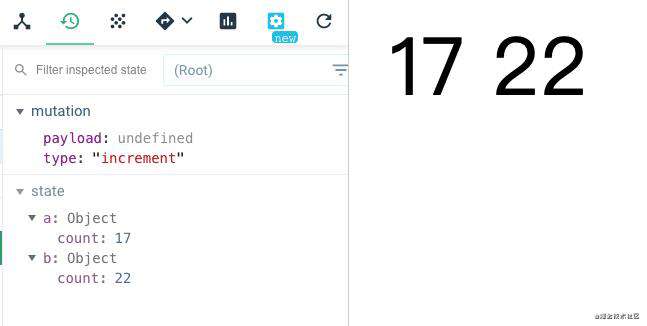Vuex进阶操作
辅助函数
mapState
前面我们说了,在组件用访问store实例中的值时我们可以使用computed计算属性,如果我们访问某一个值还好,但是如果我们需要访问多个值时,就需要在computed中写多个计算属性,这样既不省事也不优雅,对于这样的情况,Vuex为我们准备了辅助函数。
// 在单独构建的版本中辅助函数为 Vuex.mapState
import { mapState } from 'vuex'
export default {
// ...
computed: mapState({
// 箭头函数可使代码更简练
count: state => state.count,
// 传字符串参数 'count' 等同于 `state => state.count`
countAlias: 'count',
// 为了能够使用 `this` 获取局部状态,必须使用常规函数
countPlusLocalState (state) {
return state.count + this.localCount
}
})
}
当映射的计算属性的名称与 state 的子节点名称相同时,我们也可以给 mapState 传一个字符串数组。
computed: mapState([
// 映射 this.count 为 store.state.count
'count'
])
mapState 函数返回的是一个对象。我们如何将它与局部计算属性混合使用呢?通常,我们需要使用一个工具函数将多个对象合并为一个,以使我们可以将最终对象传给 computed 属性。但是自从有了对象展开运算符,我们可以极大地简化写法:
computed: {
localComputed () { /* ... */ },
// 使用对象展开运算符将此对象混入到外部对象中
...mapState({
// ...
})
}
mapGetters
mapGetters 也放在 computed 中,使用方法和mapState差不多
import { mapGetters } from 'vuex'
export default {
// ...
computed: {
// 使用对象展开运算符将 getter 混入 computed 对象中
...mapGetters([
'doneTodosCount',
'anotherGetter',
// ...
])
}
}
如果你想将一个 getter 属性另取一个名字,使用对象形式:
...mapGetters({
// 把 `this.doneCount` 映射为 `this.$store.getters.doneTodosCount`
doneCount: 'doneTodosCount'
})
mapMutations
import { mapMutations } from 'vuex'
export default {
// ...
methods: {
...mapMutations([
'increment', // 将 `this.increment()` 映射为 `this.$store.commit('increment')`
// `mapMutations` 也支持载荷:
'incrementBy' // 将 `this.incrementBy(amount)` 映射为 `this.$store.commit('incrementBy', amount)`
]),
...mapMutations({
add: 'increment' // 将 `this.add()` 映射为 `this.$store.commit('increment')`
})
}
}
mapActions
export default {
// ...
methods: {
...mapActions([
'increment', // 将 `this.increment()` 映射为 `this.$store.dispatch('increment')`
// `mapActions` 也支持载荷:
'incrementBy' // 将 `this.incrementBy(amount)` 映射为 `this.$store.dispatch('incrementBy', amount)`
]),
...mapActions({
add: 'increment' // 将 `this.add()` 映射为 `this.$store.dispatch('increment')`
})
}
}
modules
在写Vue项目时,如果一个项目过于庞大,我们会对项目进行拆分成一个个单独的组件,Vuex也是如此,当一个store实例中存储了过多内容的时候,它将变得非常臃肿,此时,我们也可以将它拆分成一个个单独的组件,类似于下面这样。
import Vue from 'vue'
import Vuex from 'vuex'
Vue.use(Vuex)
const moduleA = {
state: () => ({ count: 5 }),
mutations: {
increment (state) {
state.count++
}
},
actions: { },
getters: {
name: () => { return 'moduleA' }
}
}
const moduleB = {
state: () => ({ count: 10 }),
mutations: {
increment (state) {
state.count++
}
},
actions: { },
getters: {
name: () => { return 'moduleB' }
}
}
export default new Vuex.Store({
state: {
},
mutations: {
},
actions: {
},
modules: {
a: moduleA,
b: moduleB
}
})
模块的局部状态
对于模块内部的 mutation 和 getter,接收的第一个参数是模块的局部状态对象。
同样,对于模块内部的 action,访问模块内部的state可以使用 context.state ,访问根节点的state则可以使用context.rootState:
对于模块内部的 getter,根节点state会作为第三个参数传递进去(顺序不能错)
getters: {
sumWithRootCount (state, getters, rootState) {
return state.count + rootState.count
}
}
那我们如何去访问module中的状态和mutation等呢?在module中,state是module的局部状态,所以我们可以这样访问
this.$store.state.a.count // -> 5
默认情况下,模块内部的 action、mutation 和 getter 是注册在全局命名空间的——这样使得多个模块能够对同一 mutation 或 action 作出响应。举个栗子
mounted () {
setInterval(() => {
this.$store.commit('increment')
}, 1000)
}

我们触发一个Mutation时,模块内部的同名Mutation会同时被触发,两个模块内的state都发生了改变。action同样会如此,就不演示了,至于getters,同样会被注册到全局命名空间,如果两个module内有同名的getter,则以先引入的module为主。
import Vue from 'vue'
import Vuex from 'vuex'
Vue.use(Vuex)
const moduleA = {
state: () => ({ count: 5 }),
mutations: {
increment (state) {
state.count++
}
},
actions: { },
getters: {
name: () => { return 'moduleA' }
}
}
const moduleB = {
state: () => ({ count: 10 }),
mutations: {
increment (state) {
state.count++
}
},
actions: { },
getters: {
name: () => { return 'moduleB' }
}
}
export default new Vuex.Store({
state: {
},
mutations: {
},
actions: {
},
modules: {
a: moduleA,
b: moduleB
}
})
this.$store.getters.name // -> 'moduleA'
命名空间
那么,如果我们就想保持每个模块独立,不去影响全局空间,保持更好的封装性怎么办呢?Vuex给我们提供了提供了开启命名空间的选项,我们只需要在模块内部添加 namespaced: true 即可开启模块的命名空间。
开启了命名空间后,当前模块内的getter 和 action 会收到局部化的 getter,dispatch 和 commit,所以我们的代码无需做任何改变,但是我们在外部也就是vue组件内调用模块内的getters、actions和mutations时则需要加上模块名,由于state本来就是模块内的局部状态,所以加不加命名空间都一样
const store = new Vuex.Store({
modules: {
// 模块名:account
account: {
namespaced: true,
// 模块内容(module assets)
state: () => ({ ... }), // 模块内的状态已经是嵌套的了,使用 `namespaced` 属性不会对其产生影响
getters: {
isAdmin () { ... } // -> this.$store.getters['account/isAdmin']
},
actions: {
login () { ... } // -> this.$store.dispatch('account/login')
},
mutations: {
login () { ... } // -> this.$store.commit('account/login')
},
// 嵌套模块
modules: {
// 继承父模块的命名空间
myPage: {
state: () => ({ ... }),
getters: {
profile () { ... } // -> this.$store.getters['account/profile']
}
},
// 进一步嵌套命名空间
posts: {
namespaced: true,
state: () => ({ ... }),
getters: {
popular () { ... } // -> this.$store.getters['account/posts/popular']
}
}
}
}
}
})
那么如果我们开启了命名空间,又想在模块内部访问全局内容怎么办?
在 getter 中,我们可以接收第三个参数 rootState访问全局的 state 和 第四个参数 rootGetters 访问全局的getter
// 模块内部
getters:{
someGetter (state, getters, rootState, rootGetters) {
...
},
}
如果我们想要在模块内部的action中调用全局的action或者Mutation,只需要在调用的时候将 { root: true } 作为第三参数传给 dispatch 或 commit 即可。
// 模块内部
actions: {
someAction ({dispatch, commit}) {
dispatch('someOtherAction', null, { root: true })
commit('someMutation', null, { root: true })
}
}
在带命名空间的模块注册全局 action
若需要在带命名空间的模块注册全局 action,你可添加 root: true,并将这个 action 的定义放在函数 handler 中。就像我们需要深度监听时候使用watch一样,例如:
// 模块内部
namespaced: true,
actions: {
someAction: {
root: true, // 此action将被注册到全局空间内
handler (namespacedContext, payload) { ... }
}
}
还记得我们上面的辅助函数吗?那如果我们在模块内部开启了命名空间,又该如何去使用辅助函数呢?
mapGetters 和 mapState用法差不多,mapActions 和 mapMutations 用法差不错,这里就不重复演示了
我们共有三种方法去使用
const moduleA = {
namespaced: true,
state: () => ({ count: 5 }),
mutations: {
addMutation (state) {...}
},
actions: {
addAction ({commit}) {...}
}
}
export default new Vuex.Store({
state: {
count: 1
},
modules: {
moduleA // moduleA:moduleA 使用ES6的语法简写为 moduleA
}
})
// => 可以简化为
computed: {
...mapState('moduleA', {
count: state => state.count
})
}
第一种:在用的时候带上路径
import { mapState, mapMutations } from 'vuex'
computed: {
...mapState({
count: state => state.moduleA.count // => 5
})
},
methods: {
...mapMutations([
'moduleA/addMutation' // 用的时候 this['moduleA/addMutation']()
])
...mapMutations({
addMutation: 'moduleA/addMutation' // 用的时候 this.addMutation()
})
}
第二种:在第一个参数传入module名
import { mapState, mapMutations } from 'vuex'
computed: {
...mapState(‘moduleA’, {
count: state => state.count // => 5
})
},
methods: {
...mapMutations(‘moduleA’, [
'addMutation' // 用的时候 this.addMutation()
])
...mapMutations(‘moduleA’, {
addMutation: 'addMutation' // 用的时候 this.addMutation()
})
}
第三种:使用 createNamespacedHelpers
import { createNamespacedHelpers } from 'vuex'
const { mapState, mapMutations } = createNamespacedHelpers('moduleA')
computed: {
...mapState({
count: state => state.count // => 5
})
},
methods: {
...mapMutations([
'addMutation' // 用的时候 this.addMutation()
])
...mapMutations({
addMutation: 'addMutation' // 用的时候 this.addMutation()
})
}
模块重用
有时我们可能需要创建一个模块的多个实例,例如:
- 创建多个 store,他们公用同一个模块 (例如当 runInNewContext 选项是 false 或 'once' 时,为了在服务端渲染中避免有状态的单例 )
- 在一个 store 中多次注册同一个模块
如果我们使用一个纯对象来声明模块的状态,那么这个状态对象会通过引用被共享,导致状态对象被修改时 store 或模块间数据互相污染的问题。
实际上这和 Vue 组件内的 data 是同样的问题。因此解决办法也是相同的——使用一个函数来声明模块状态(仅 2.3.0+ 支持):
const MyReusableModule = {
state: () => ({
foo: 'bar'
}),
// mutation, action 和 getter 等等...
}
扩展知识
v-model双向绑定state中的值
官方不推荐我们直接使用 v-model 直接去绑定state中的值,并且如果我们开启了严格模式,这样做还会报错,那如果我们用vue的思维去解决这个问题,就是使用v-model绑定一个值,然后去监听这个值的变化,之后使用commit去改变state中的值,这样做难免过于繁琐,官方推荐的最优雅的方式是去利用计算属性的 getter 和 setter 属性
// ...
mutations: {
updateMessage (state, message) {
state.obj.message = message
}
}
<input v-model="message">
// ...
computed: {
message: {
get () {
return this.$store.state.obj.message
},
set (value) {
this.$store.commit('updateMessage', value)
}
}
}
好啦,本篇文章的内容就到此为止啦,时间仓促,知识繁多,学艺不精,难免出错,如果各位大佬有人发现文中不对的地方,希望给与指正,谢谢,希望可以帮到大家,祝大家工作顺利?
常见问题FAQ
- 免费下载或者VIP会员专享资源能否直接商用?
- 本站所有资源版权均属于原作者所有,这里所提供资源均只能用于参考学习用,请勿直接商用。若由于商用引起版权纠纷,一切责任均由使用者承担。更多说明请参考 VIP介绍。
- 提示下载完但解压或打开不了?
- 找不到素材资源介绍文章里的示例图片?
- 模板不会安装或需要功能定制以及二次开发?




发表评论
还没有评论,快来抢沙发吧!